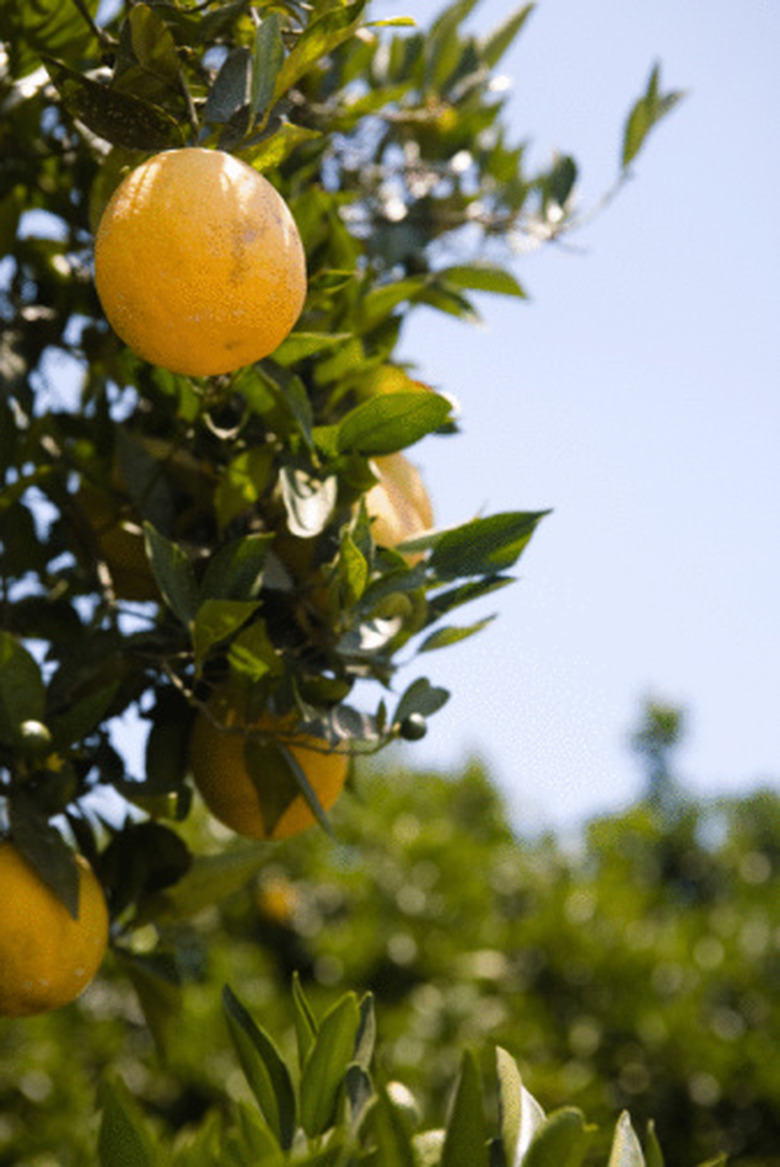What Is The Life Cycle Of An Orange Tree?
Orange trees can live long lives. The St. Dominic's orange tree in Rome, for instance, was propagated in 1938 from roots that originated 800 years ago. With proper care, orange trees can definitely last a lifetime. Oranges have a yearly cycle of growth, flower production, and fruiting.
Orange trees can live long lives. The St. Dominic's orange tree in Rome, for instance, was propagated in 1938 from roots that originated 800 years ago. With proper care, orange trees can definitely last a lifetime. Oranges have a yearly cycle of growth, flower production, and fruiting.
Winter
Oranges are best grown in mild climates in sandy well-drained soils. November through February are peak times to pick fully ripened oranges.
Spring
Springtime orange blossoms scent the air with an aroma like no other. Driving past a Florida orange grove in March and April is an aromatically unforgettable experience. The flowers are pollinated by droves of bees and begin the process of setting fruit.
- Orange trees can live long lives.
- November through February are peak times to pick fully ripened oranges.
Summer
During summer the orange trees convert sunshine into nutrients for developing fruit. Fruits remain green until fall when the decrease in daylight and cooler temperature trigger them to turn orange.
Picking Fruit
Cool fall days cause the orange fruits to become sweeter. A few taste tests will indicate when fruits are sweetest and ready for picking.
Long life
Orange trees grown in the home landscape can remain in production for more than 100 years if tree is cared for with proper pruning of suckers and dead branches, regular fertilizer applications, and protection from freezing temperatures.
Life Cycle Of An Orange Fruit
So many types of oranges have been developed through the years that the orange is now the most commonly grown tree fruit in the world. The sweet orange, what we commonly drink as orange juice (Citrus aurantium var. Further distinctive characteristics can be identified between the two categories. Although it's possible to grow oranges in zone 8, you'll have to take extra precautions. The most popular varieties change with the times; however, some current strong contenders include the 'Valencia', 'Hart's Tardiff Valencia' and the 'Hamlin', but there are dozens of other types. ** In the blood orange category, varieties of orange fruit include the 'Maltese', 'Moro', 'Sanguinelli', 'Scarlet Navel' and 'Tarocco'. The navel orange, which is extremely popular around the world for its easily removed rind and easy separation of segments, is of great commercial importance and one of the most popular oranges sold in grocery stores. A species of numerous uses, the bitter orange (Citrus aurantium), is also known as the sour, bigarade or Seville orange. The bitter orange is native to southeastern Asia. The fruit has a round, oblong-oval shape and a rough surface, with a relatively thick, aromatic, bitter peel. It develops into a vivid reddish-orange hue on maturity and has minute, dimpled oil glands. Bergamot orange_ (C. bergamia), grown in Italy for its peel, is used in perfumes and to flavor Earl Grey tea. Trifoliate orange (C. trifoliata) is also sometimes included in this group, and it's also used as rootstock for sweet orange trees. When seed-grown trees do take root and thrive, they can take up to 15 years to reach maturity, and only then will they start to produce fruit. As a result, growing seedlings is considered the best formula for success. Visit your local nursery to purchase a grafted tree. As a rule of thumb, orange trees requires frequent watering in spring to thwart wilting as well as to suppress irrigation in the fall season. For an increased productivity in edible fruit, add up to 1 to 2 pounds of nitrogen annually to each individual tree. Fertilization may also be applied by spraying the leaves a few times a year. Growers have found that commercially grown oranges thrive in a Mediterranean and subtropical environment, where the weather is warm, with brisk nights reaching a low of about 40 degrees Fahrenheit, which turns the skin of the oranges from green to vivid orange. Some varieties of oranges, like blood oranges, have a red-orange skin. Unlike other fruit, oranges don't continue to ripen once they have been picked. Orange tree care is not complicated. Citrus is not just a summer fruit; in fact, many types of citrus are available year-round. This is considered by many to be the peak time. From January until April is the time for sweet and juicy flavors in many oranges. Others, like the navel, are available perhaps half the year or longer. The season for oranges usually begins in November. Heavy rainfall produces quicker yields. May is generally the end of the orange season, depending on rain amounts, but the season can end a little sooner or later.
- During summer the orange trees convert sunshine into nutrients for developing fruit.
- Orange trees grown in the home landscape can remain in production for more than 100 years if tree is cared for with proper pruning of suckers and dead branches, regular fertilizer applications, and protection from freezing temperatures.
- Bergamot orange_ (C. bergamia), grown in Italy for its peel, is used in perfumes and to flavor Earl Grey tea.
- Trifoliate orange (C. trifoliata) is also sometimes included in this group, and it's also used as rootstock for sweet orange trees.
- The season for oranges usually begins in November.
References
- Home Citrus Growers: St. Dominic's Orange Tree at the Convent of St. Sabina in Rome
- USDA: California and Arizona Orange Grades and Standards
- Colorado State.edu: Food Source Information: Oranges
- Purdue.edu: Orange Citrus sinensis
- Purdue.edu: Sour Orange
- Purdue.edu: Mandarin Orange
- Ag Foundation: How Do Oranges Grow?
